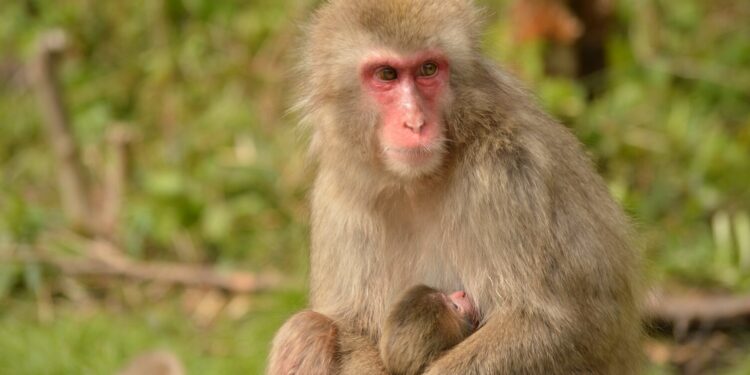A female Japanese macaque breastfeeding her baby, a few days old. Japanese macaques, also known as snow monkeys, give birth in spring and early summer. This early summer delivery period allows the infant to grow and become strong enough in winter to survive the cold months. Credit: Angela Stojan
An international research team led by the University of Vienna and the Medical University of Vienna used long-term population data on Japanese macaques, a species of monkey in the Old World monkey family, to show that unlike humans, there is no maternal mortality in monkeys. these primates linked to childbirth. The study results were recently published in the journal PNAS.
The evolution of large brains and associated large fetal heads are key factors linked to maternal mortality in primates during childbirth. For humans, the baby’s large head compared to the mother’s narrow birth canal can lead to serious birth complications. In countries with poor medical care, up to 1.5% of mothers die in childbirth as a result of childbirth. Macaques have a pelvis-to-fetal head ratio similar to that of humans. However, it is unclear whether they face birth complications and maternal mortality similar to humans.
Biologists and midwives from the University of Vienna, the Medical University of Vienna, the Konrad Lorenz Institute for Research on Evolution and Cognition (Klosterneuburg) and the University of Kyoto ( Japan) investigated whether this was the case. Their research was based on long-term demographic data on births and deaths collected from a population of semi-free-living Japanese macaques housed at the Affenberg in Landskron, Carinthia, Austria.
During the 27-year study period, 281 infants were born to 112 female macaques. Affenberg’s semi-free environment offers scientists the opportunity to study the behavior and reproduction of Japanese macaques in near-natural conditions. Since 2019, Affenberg has been affiliated with the University of Vienna (Department of Behavioral and Cognitive Biology).
A female Japanese macaque breastfeeding her baby, a few weeks old. Japanese macaques give birth to their babies between spring and early summer and nurse them for seven months to a year. After about a month, infants begin to eat more solid foods. In winter, they are strong enough to survive the cold months. Credit: Angela Stojan
No maternal mortality in macaques
“We were able to show for this population that no female has died in connection with the birth of her young over the past 27 years,” explains Katharina Pink, midwife and evolutionary anthropologist from the Department of Obstetrics and Medicine. feto-maternal of the Institute. Medical University of Vienna and co-first author of the study. This result shows that Japanese macaques do not face the same risk of maternal mortality as humans, despite having an equally narrow pelvis/head ratio.
Why childbirth appears less risky in macaques than in humans remains an open question. The research team offers possible explanations for this surprising result.
“We believe that the pelvic girdle and pelvic floor muscles in macaques have greater flexibility during labor than in humans and that the dynamics of birth are less restricted due to differences in pelvic morphology,” explains Barbara Fischer, also co-first author and scientist at the Institute. Department of Evolutionary Biology at the University of Vienna and the Konrad Lorenz Institute for Evolution and Cognition Research.
A female Japanese macaque breastfeeding her six-month-old baby in winter. Japanese macaques, also known as snow monkeys, give birth to their babies between spring and early summer so that they are strong enough to survive the cold winter months. Credit: Angela Stojan
Intuitive childbirth and freedom of movement
To date, there are very few scientific reports on the births of free-living non-human primates. Most of these births take place at night or in the early morning hours and are therefore difficult to observe. The birth events described show that non-human primates intuitively prefer standing or squatting birthing positions and therefore likely make ideal use of pelvic flexibility.
“These observations could inspire future studies aimed at better understanding how freedom of movement during physiological birth can lead to more individualized and less invasive care for mothers,” says Pink, a midwife.
More information:
Katharina E. Pink et al, No birth-associated maternal mortality in Japanese macaques (Macaca fuscata) despite birth of large-headed newborns, Proceedings of the National Academy of Sciences (2024). DOI: 10.1073/pnas.2316189121. doi.org/10.1073/pnas.2316189121
Provided by the University of Vienna
Quote: Macaques give birth more easily than women: a study reveals no maternal mortality at birth (October 7, 2024) retrieved October 7, 2024 from
This document is subject to copyright. Except for fair use for private study or research purposes, no part may be reproduced without written permission. The content is provided for informational purposes only.



